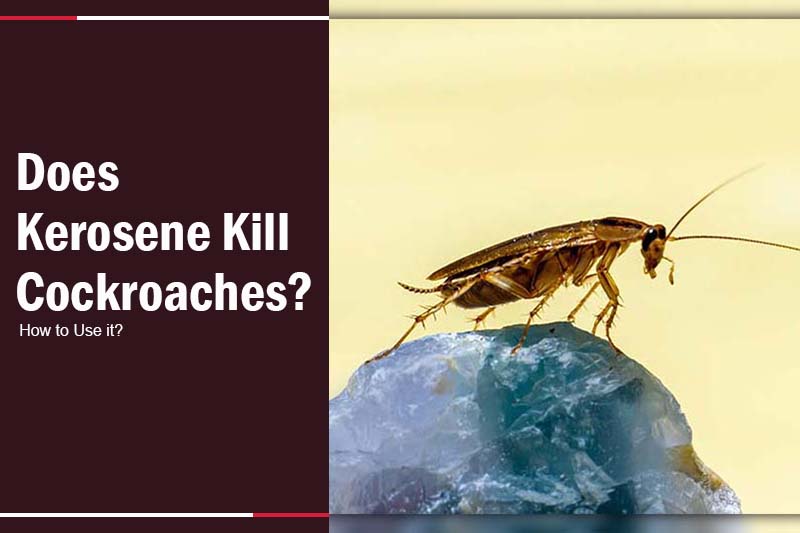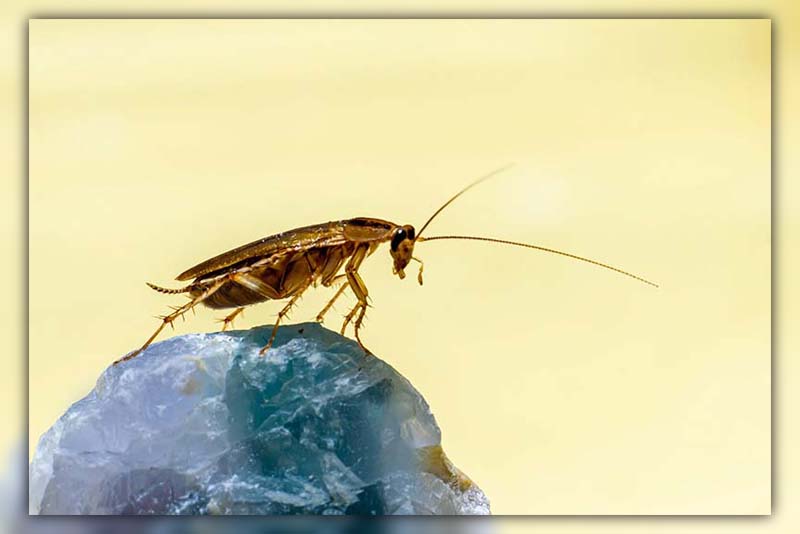Are you frustrated by a relentless army of cockroaches invading your home?
Have you heard rumors about the power of kerosene against these pesky invaders and wondered, “Can kerosene kill cockroaches?”
Dive into our comprehensive guide to explore the pros and cons of using kerosene oil for cockroaches, along with safer and more effective alternatives for a roach-free home.

Can Kerosene Eliminate Cockroaches?
Yes, kerosene can swiftly dispatch roaches. But before you reach for that bottle of kerosene, it’s essential to understand that it may not be your best bet.
The use of kerosene in your quest to eliminate cockroaches has its drawbacks. Firstly, it comes with serious safety concerns.
The inhalation of kerosene vapors can trigger respiratory issues.
Moreover, its flammability presents a potential fire hazard, especially if it comes into contact with an open flame or spark.
And let’s not forget the potent aroma it leaves behind, which can linger for days, making your living spaces less than pleasant.
>> Read more: Can lysol kill roaches? The Surprising Answer Revealed!
How Does Kerosene Kill Cockroaches?
When roaches encounter kerosene, they don’t merely get a sticky foot or two. Instead, the toxic nature of kerosene goes to work immediately.
Cockroaches, with their unique exoskeletal structure inadvertently absorb kerosene.
This absorption proves lethal, primarily because kerosene acts as a neurotoxin for these critters.
Once it infiltrates their system, it disrupts their nervous functions, eventually leading to paralysis and, subsequently, death.
A factor that exacerbates this effect is the cockroach’s anatomy.
Their high surface area to volume ratio – a fancy way of saying they have a lot of skin for their size – means that their exoskeleton is quite thin relative to their overall body.
This thinness facilitates the easy penetration of kerosene, allowing it to wreak havoc inside their bodies.
Cockroaches playing dead is a common behavior to avoid predators or threats.
They may curl up their legs and stop moving, hoping that the danger will pass by.
However, this strategy does not work with kerosene, a toxic substance that can kill roaches quickly.
How to Kill Cockroaches Using Kerosene?
While there are certainly safer and more effective methods to rid your home of cockroaches, for those hell-bent on employing kerosene, it’s crucial to follow a systematic approach for safety’s sake:
- Step 1: Survey your home to ascertain roach hotspots. Typically, kitchens, bathrooms, and dark nooks and crannies are their preferred haunts.
- Step 2: Dilute kerosene with water in a 1:10 ratio, reducing its flammability.
- Step 3: Using a spray bottle, aim the diluted kerosene at the identified roach areas. Take special care to get into those cracks and crevices where these pests often lurk.
- Step 4: Allow a few moments for the kerosene to work its lethal magic. Cockroaches exposed to the solution will soon perish.
- Step 5: Once done, ensure you collect and dispose of the dead roaches appropriately.
A word of caution: keep kerosene away from open flames, such as gas stoves or heaters. Also, always prioritize the safety of children and pets by ensuring they don’t come into contact with areas treated with kerosene.
Although kerosene can prove effective against cockroaches, bait traps or specific insecticides are preferable and safer DIY approaches.
How to Safely Use Kerosene to Repel & Kill Roaches?
If you are going to choose kerosene for repelling and killing cockroaches, do not use it in the evening especially in a house that you intend to sleep in.
You also need to use it in very small drops and consider being specific. You do not want to go spraying the whole house with kerosene even in areas where there are no roaches.
Identify and keep your target locked before you aim for it. Here is how to use kerosene to get rid of roaches at home;
- Take time to first identify where the cockroaches hide at home.
- Get a clean dry hand spray and pour some kerosene in it.
- Ensure there is nothing that can start a fire around and have some gloves on.
- Spay the kerosene directly on the infected area in small quantities.
- Sit back, wait for them to die before you sweep them out.
- You may also want to do this when you want to travel for 1 or 2 days for better results.
- This will help the kerosene smell settle long enough for the roaches to run away.
How to get rid of kerosene smell after using it for roaches?
After finishing the above steps, the next step will help you in getting rid of the kerosene smell in the areas that you have sprayed in on:
- Ensure you do this in the morning so that you have the whole day for aeration.
- Get 3 cups of hot water.
- Get one cup of household ammonia.
- One cup of White Vinegar.
- One cup of washing soda.
- Add all this in a clean container and stir to mix.
- Get a clean piece of cotton cloth and soak it in the solution.
- Use this to clean the area generously so that the smell of kerosene is gone.
- The smell of vinegar combined with baking soda will also help in repelling any roaches that may want to come back.
- Leave the windows open and doors so that the room is well aerated and free from the fumes.
You may also get rid of the kerosene smell from your hands by simply rubbing a little baking soda then add a few drops of vinegar together in your hands.
You can then let this settle for about 15-20 minutes before you wash with soap and water.
>> Read more: Can Ammonia kill roaches? Unmasking the Truth.
Alternatives to Kerosene for Killing Cockroaches
Choosing kerosene to battle cockroaches is a risky affair, given its hazardous nature. Thankfully, there are multiple safer and more efficient alternatives to tackle these household pests:
Bait Traps
Bait traps are commercial cockroach assassins.
These crafty devices combine food with a slow-acting poison, luring roaches into a deadly feast.
Once consumed, the poisoned cockroach heads back to its nest, inadvertently contaminating its fellow pests.
Over time, this domino effect significantly reduces or eradicates the colony.
The strength of bait traps lies in their ability to target not just the seen, but the unseen roaches, leveraging their natural behavior for comprehensive extermination.
Sticky Traps
Think of sticky traps as roach flypapers. Placed strategically where roaches frequent, these adhesive-coated traps ensnare unsuspecting cockroaches.
With no toxins involved, sticky traps are kid-friendly and pet-safe.
However, their scope is limited, capturing only those roaches that tread on them.
Thus, for a thorough cleanup, combining sticky traps with other methods might be more effective.
Boric Acid
Boric acid is answer to cockroach infestations.
Harmless to humans and pets but fatal to roaches, a sprinkling of this natural insecticide along roach trails can be highly effective.
As roaches scuttle over the boric acid powder, they ingest it, sealing their fate.
Diatomaceous Earth
Derived from fossilized remains of minuscule aquatic organisms or diatoms, diatomaceous earth is a potent roach exterminator.
Safe for humans and pets but lethal to insects, this powder works by dehydrating its insect victims.
Like with boric acid, sprinkle diatomaceous earth in roach-prone areas to deliver a crushing blow to these pests.
While it’s essential to choose an effective method to rid your home of cockroaches, it’s equally vital to select a method that’s safe for you and your loved ones.
Always weigh the pros and cons and, if in doubt, consult a professional exterminator.
>> Read more: How to get rid of roaches fast without an exterminator?
Conclusion
While kerosene can indeed kill cockroaches, its potential hazards make it less advisable than other safer methods. Ensuring the safety of your home and loved ones should always be the top priority.
For more insights on pest control and innovative solutions, don’t hesitate to explore more articles from Pestweek.

Calina Mabel has over 15 years of experience in the field of journalism and communications. Currently, Calina Mabel is the Content Writer for categories such as Cockroach, Ants, Bed Bugs, Mosquito, Rodent, Termite, and Flies on Pestweek.com. She aims to build content for these categories with a focus on providing valuable and accessible information to readers, in order to create the world’s largest knowledge community about Pests.
All content written by Calina Mabel has been reviewed by Emily Carter.


